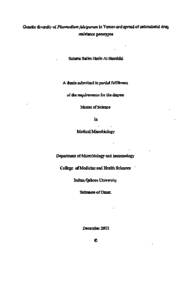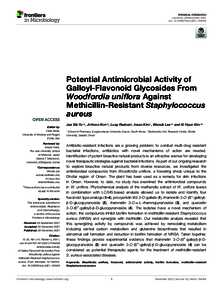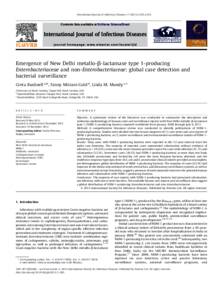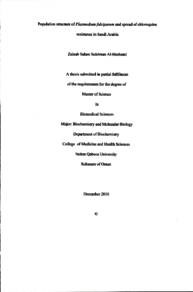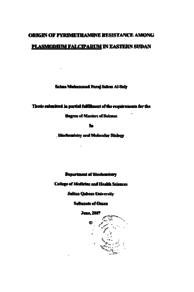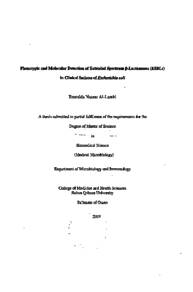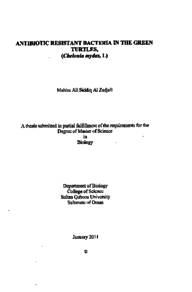وثيقة
Genetic diversity of plasmodium falciparum in Yemen and spread of antimalarial drug resistance genotypes
الناشر
Sultan Qaboos University
ميلادي
2012
اللغة
الأنجليزية
الملخص الإنجليزي
Introduction: Malaria is a major disease, caused by Plasmodia parasites, and is widely distributed in tropical and subtropical areas. The Arabian Peninsula lies at fringes of malaria endemicity, where successful control efforts have brought local transmission to halt in many parts of this region. However, limited foci in Yemen and southern Saudi Arabia remain malarious, with a high prevalence of drug-resistant P. falciparum parasites. The aims of this thesis are to assess the prevalence of drug resistance P. falciparum genotypes in Yemen, and characterize the genetic structure of the parasites. This includes analysis of genes associated with resistance to commonly used anti-ma drugs, including chloroquine, Fansidar, mefloquine and artemisinin. In addition, the study examined microsatellites flanking these genes to assess the source of resistance in Yemen, and its relationship to drug resistance genotypes seen in Jazan area, south west Saudi Arabia.
Material and methods: Hundred and fifteen, parasitologically confirmed, malaria patients from three areas (Dhamar, Hodeidah, and Taiz) in Yemen were recruited for this study. In addition, 90 P. falciparum isolates were collected from patients in Jazan area, south west Saudi Arabia. Single nucleotide polymorphisms (SNPs) in the P. falciparum chloroquine resistance transporter (Pfort) (C725, M741, N75E, K76T), multidrug resistance (Pfmdrl) (N86Y, Y184F, $1034C, N1042D, D1246Y), dihydrofolate reductase (dhfr) (N511, C59R, $108N, 1164L) and dihydropteroate synthase (dhps) (S436F, A437G, K540E, A6139) genes were examined using PCR and sequencing. In addition, 13 single copy microsatellites flanking the above genes were examined by capillary electrophoresis. Moreover, alleles of two polymorphic genes (MSP-2 and Pfg377) not involved in drug resistance were tested, to examine the genetic background of parasites in Yemen and Saudi Arabia.
Results: High prevalence of SNPs and mutant genotypes of Pfort and Pfmdr/ associated with chloroquine resistance (COR) were seen in Yemen. Two mutant Pfcrt genotypes CVIET and SVMNT existed in Yemen at a prevalence of 89% and 4%, respectively. Analysis of microsatellites flanking Pfort, revealed presence of 33 haplotypes, 8 carried the wild-type, 22 (66.7%) harboured genotype CVIET and 3 (9%) contained genotype SVMNT. Regarding Pfmdr1, four SNPs were detected, 86Y (2%), 184F (99%), 10340 (70%) and 1042D (70%). The majority of P. falciparum isolates carried the Pfmdr/ mutant genotype NFCDD (57%). Analysis of microsatellites flanking Pfmdrl, revealed presence of 72 haplotypes, 1 (1.4%), 19 (26.4%), 7 (9.7%), 36 (50%) and 9 (12.5%) haplotypes harboured the wild-type, NFSND, YFSND, NFCDD and YFCDD genotype, respectively. With regard to dhfr and dhps, 58 (54%) of isolates carried the double mutant dhfr genotype ICNI; however no dhps mutations were detected. Analysis of microsatellites flanking dhfr, revealed presence of 47 haplotypes, 34 (72.3%) harboured the wild-type and 13 (27.7%) contained genotype ICNI.
High diversity was seen among the other genes, Pfg377 (expected heterozygosity, He= 0.66) and MSP-2 (He =0.80). Five alleles of Pfg377 were detected, their sizes varied between 269 bp and 353 bp. Similarly, 15 and 30 alleles of the MSP-2 allelic types, FC27 and 3D7 were seen among parasites, respectively. The rate of mixed genotype infection was high (57%) with an average of 1.8 genotypes/ patient. This agrees with the absence of LD between the drug resistance genes (Pfort, Pfmdr), dhfr and dhps) and the non drug resistance genes (Pfg377 and MSP-2) (p<0.05). Comparison between P. falciparum parasites in Yemen and Saudi Arabia showed lower Fs (0.003) for the neutral gene (Pfg377). This suggest gene flow between parasites in the two regions. Nonetheless, a relatively higher F (0.091 to 0.111) was seen for the microsatellites, on chromosome 8 and MSP-2 (F= 0.062). In contrast to the above genes, there was a significant difference in distribution of drug resistance genes as well as the MSP-2 genes between the two regions. The Pfcrt CVIET was the predominant mutant genotype in both countries, however, genotype SVMNT was only seen in Yemen. Similar to Pfort, the double mutant dhfr ICNI existed at significant difference prevalence in both Yemen and Saudi Arabia. Moreover, the genetic background (flanking microsatellite) of the most dominant mutant genotypes of Pfort (CVIET) and dhfr (ICNI) are different in the two sites.
Conclusion: Pfort and Pfmdr/ mutations implicated in resistance to CQ, mefloquine and lumefantrine existed at high prevalence in Yemen. However, mutations in dhfr and dhps associated with sulfadoxine-pyrimethamine (SP) resistance were limited or absent, suggesting high efficacy of SP. The presence of two distinct haplotypes of Pfort suggests that CQR in Yemen has evolved from two independent origins. The source of these CQR lineages can be linked to Africa and Asia, however, the high degree of parasite diversity and recombination between different genotypes have generated an array of haplotypes of the two Pfcrt genotypes (CVIET and SVMNT). In contrast to parasites in Yemen, limited genetic diversity was seen among parasites in Saudi Arabia. Difference in distribution of MSP-2 alleles and drug resistance genes between the two regions can be explained by variation in selection pressure on these genes. However, the shared drug resistance haplotypes in the two regions support the findings of low Fs for the neutral gene (Pfg377), suggest gene flow between of parasites in the two regions, as a result of human movement.
المجموعة
URL المصدر
الملخص العربي
ملخص البحث مقدمة: الملاريا هي واحدة من أخطر الأمراض القاتلة الناتجة عن الإصابة بطفيل البلازموديوم حيث ينتشر هذا المرض في المناطق الاستوائية وشبه الاستوائية. أما بالنسبة لشبه الجزيرة العربية فتعتبر من المناطق الأقل عرضة لوبائية الملاريا حيث إن العديد من الجهود المبذولة لمكافحة المرض ساهمت في التقليل من انتشاره في المنطقة. وعلى الرغم من ذلك إلا أن بعض الدول في شبه الجزيرة العربية كاليمن وجنوب غرب المملكة العربية السعودية مازالت تصنف من المناطق الموبوءة بالملاريا والتي سجلت وجود طفرات جينية في طفيل البلازموديوم فالسيبارم مقاومة للعلاج في كلا الدولتين.
الأهداف: هدفت هذه الدراسة إلى وصف التركيبة الجينية لطفيل البلازموديوم فالسیپارم في اليمن، وتحديد نسبة انتشار الأنواع الجينية المقترنة بمقاومة الطفيل لعقاقير الملاريا. بالإضافة إلى دراسة مصدر نشوء الأنواع المقاومة العقاقير في اليمن و مقارنتها مع الأنواع المقاومة للعقاقير في منطقة جيزان بجنوب غرب المملكة العربية السعودية. بالإضافة في تتبع أصل البلازموديوم فالسيبارم المقاوم للعقار كلوروكوين , الفنسدار , مفلوكوين والارتمسنين . ومعرفة في ما إذا كان ينحدر من نفس الأصول الأفريقية المجاورة ووصل للسعودية عن طريق حركة الهجرة الجينية أم أنه تطور ونشا محليا۔
الطرق:تضمنت الدراسة 115 عينة من المرضى المصابين بطفيل البلازموديوم فالسيبارم الذي تم الكشف عنه مجهريا في كل من المناطق ظمر, حديدة و تعز باليمن. كما تضمنت 90 عينة من طفيل البلازموديوم فالسيبارم جمعت من مرضى من منطقة جيزان. تم الكشف عن الطفرات الوراثية المرتبطة بمقاومة الطفيل العقارات الملاريا الموجودة في جين Pfert و هي (C72S, M741, N75E K76T) وجين N86Y, Y184F, S1034C, N1042D, Pfmdrl) (D1246Y وجین dps وهي (S436F, A437G, K540E, A613S) و جین dhf وهي , N51I, C598 ) ( S108N, I164L عن طريق تقنيات خاصة لتكثير وتحليل الوحدات الوراثية (PCR and sequencing). بالإضافة إلى ذلك، فإن 13جزء من أجزاء من المنطقة الوراثية (microsatellites) محيطة بهذه الجينات لتحديد الخلفية الجينية للطفيل في مناطق اليمن و المملكة العربية السعودية. تم دراستها بالإضافة إلى جين Pf377 و 2-MSP ليس له علاقة بمقاومة العقار. النتائج: شوهد انتشارا عاليا من تعدد الأشكال والأنماط الجينية في كل من Perr ولPfindr المرتبطة ب COR في اليمن. وكما كان وجود اثنين من مورثات طفرة انتقال المرض CVTET و SVMNT في اليمن في بنسبة انتشار 789 و 4٪ على التوالي. ودراسة الأجزاء المحيطة بالجين Pfert كشفت عن وجود 33 هبلوتيب و 8 منها لا تحمل طفرات و 22 CVIET و3 SVMNT. فيما يتعلق Pfdrl، تم الكشف عن اربع النيوكلوتاید، (2) ٪184F (99) ، % 86Y (70) 1042D (70) % 1034C ٪. وغالبية البلازموديم فالسيبارم في اليمن لديها NFCDD (57٪) Pfmdr1. بالنسبة اللهبلوتيب هناك 72 نوعا : 36، 1 ، 19 ، 7 و 9 تحمل كل من النوع ليس به طفرات والنمط الجيني YFSND ، NFSND وNFCDD YFCDD، على التوالي. وفيما يتعلق dhfوdhpS % 53. 7 من البلازموديم الفالسيبارم لدية طفرات جينية في الجين dhf في اليمن، ولكن لا يوجد عن الطفرات في الجين dhps. أيضا كشفت وجود من 47 هبلوتيب في 34dfr النسخ ليس بها طفرات و 13 به طفرات وراثي. وكشف عن وجود درجة عالية من التنوع من الجينات محايدة 377 = He ) P 0. 66) و2- He
) MSP = 0. 80) في اليمن. تم الكشف عن خمسة من الأليلات Pfg377، تختلف أحجامها بين bp 269 وbp 353. وبالمثل، 15و 30 الأليلات من أنواع 2- FC27 ، SP ر 3D7 بين الطفيليات في اليمن، على التوالي. وقد شوهد ارتفاع تعدد النمط الوراثي 57٪ (مع الأنماط الوراثية 1. 8 ، متوسط المريض في اليمن . هذا يتفق مع غياب LD بين الجينات
dhpsdhfr ، Pfmdr / ، Pfcrt والجينات محايدة Pfg377 و 2-P MSP <0.05 وأظهرت المقارنة بين بلازموديم فالسیپارم في اليمن والمملكة العربية السعودية اختلافا كبيرا في توزيع الجينات المقاومة للأدوية والجينات المحايدة. تفاوتت نسبة انتشار وانتقال المرض من dhfi هبلوتيب بشكل كبير بين الموقعين؛ CVTETكان النمط الجيني السائد متحولة في كلا البلدين، ومع ذلك، SVMNT فقط الوراثي في اليمن. واعتبرت القيم عالية بين الأليلات من (MSP - 2 (
0. 062 = Fst و الأجزاء المرافقة لجين Fst) dhps تتراوح بين 0. 091 و الخاتمة: تنتشر الطفرات الوراثية في الجينين Pfert و Phmdr1 المرتبطة بمقاومة الطفيل العقارات الملاريا chloroquine, mefloquine و lumefantrine بنسبة انتشار واسعة في اليمن بعكس الطفرات الوراثية في الجينين dhf ويdhp لها نسبة انتشار محدود جدا, مما يوحي بفعالية عقار SP . تميزت المملكة العربية السعودية بتنوع جيني بعكس الملاحظ في اليمن. كما ينم الاختلاف الواضح في نسبة انتشار الطفرات الوراثية بين المنطقتين على عدم وجود تدفق جيني و بالتالي يستنتج أن الطفيل في المنطقتين مختلف .
الأهداف: هدفت هذه الدراسة إلى وصف التركيبة الجينية لطفيل البلازموديوم فالسیپارم في اليمن، وتحديد نسبة انتشار الأنواع الجينية المقترنة بمقاومة الطفيل لعقاقير الملاريا. بالإضافة إلى دراسة مصدر نشوء الأنواع المقاومة العقاقير في اليمن و مقارنتها مع الأنواع المقاومة للعقاقير في منطقة جيزان بجنوب غرب المملكة العربية السعودية. بالإضافة في تتبع أصل البلازموديوم فالسيبارم المقاوم للعقار كلوروكوين , الفنسدار , مفلوكوين والارتمسنين . ومعرفة في ما إذا كان ينحدر من نفس الأصول الأفريقية المجاورة ووصل للسعودية عن طريق حركة الهجرة الجينية أم أنه تطور ونشا محليا۔
الطرق:تضمنت الدراسة 115 عينة من المرضى المصابين بطفيل البلازموديوم فالسيبارم الذي تم الكشف عنه مجهريا في كل من المناطق ظمر, حديدة و تعز باليمن. كما تضمنت 90 عينة من طفيل البلازموديوم فالسيبارم جمعت من مرضى من منطقة جيزان. تم الكشف عن الطفرات الوراثية المرتبطة بمقاومة الطفيل العقارات الملاريا الموجودة في جين Pfert و هي (C72S, M741, N75E K76T) وجين N86Y, Y184F, S1034C, N1042D, Pfmdrl) (D1246Y وجین dps وهي (S436F, A437G, K540E, A613S) و جین dhf وهي , N51I, C598 ) ( S108N, I164L عن طريق تقنيات خاصة لتكثير وتحليل الوحدات الوراثية (PCR and sequencing). بالإضافة إلى ذلك، فإن 13جزء من أجزاء من المنطقة الوراثية (microsatellites) محيطة بهذه الجينات لتحديد الخلفية الجينية للطفيل في مناطق اليمن و المملكة العربية السعودية. تم دراستها بالإضافة إلى جين Pf377 و 2-MSP ليس له علاقة بمقاومة العقار. النتائج: شوهد انتشارا عاليا من تعدد الأشكال والأنماط الجينية في كل من Perr ولPfindr المرتبطة ب COR في اليمن. وكما كان وجود اثنين من مورثات طفرة انتقال المرض CVTET و SVMNT في اليمن في بنسبة انتشار 789 و 4٪ على التوالي. ودراسة الأجزاء المحيطة بالجين Pfert كشفت عن وجود 33 هبلوتيب و 8 منها لا تحمل طفرات و 22 CVIET و3 SVMNT. فيما يتعلق Pfdrl، تم الكشف عن اربع النيوكلوتاید، (2) ٪184F (99) ، % 86Y (70) 1042D (70) % 1034C ٪. وغالبية البلازموديم فالسيبارم في اليمن لديها NFCDD (57٪) Pfmdr1. بالنسبة اللهبلوتيب هناك 72 نوعا : 36، 1 ، 19 ، 7 و 9 تحمل كل من النوع ليس به طفرات والنمط الجيني YFSND ، NFSND وNFCDD YFCDD، على التوالي. وفيما يتعلق dhfوdhpS % 53. 7 من البلازموديم الفالسيبارم لدية طفرات جينية في الجين dhf في اليمن، ولكن لا يوجد عن الطفرات في الجين dhps. أيضا كشفت وجود من 47 هبلوتيب في 34dfr النسخ ليس بها طفرات و 13 به طفرات وراثي. وكشف عن وجود درجة عالية من التنوع من الجينات محايدة 377 = He ) P 0. 66) و2- He
) MSP = 0. 80) في اليمن. تم الكشف عن خمسة من الأليلات Pfg377، تختلف أحجامها بين bp 269 وbp 353. وبالمثل، 15و 30 الأليلات من أنواع 2- FC27 ، SP ر 3D7 بين الطفيليات في اليمن، على التوالي. وقد شوهد ارتفاع تعدد النمط الوراثي 57٪ (مع الأنماط الوراثية 1. 8 ، متوسط المريض في اليمن . هذا يتفق مع غياب LD بين الجينات
dhpsdhfr ، Pfmdr / ، Pfcrt والجينات محايدة Pfg377 و 2-P MSP <0.05 وأظهرت المقارنة بين بلازموديم فالسیپارم في اليمن والمملكة العربية السعودية اختلافا كبيرا في توزيع الجينات المقاومة للأدوية والجينات المحايدة. تفاوتت نسبة انتشار وانتقال المرض من dhfi هبلوتيب بشكل كبير بين الموقعين؛ CVTETكان النمط الجيني السائد متحولة في كلا البلدين، ومع ذلك، SVMNT فقط الوراثي في اليمن. واعتبرت القيم عالية بين الأليلات من (MSP - 2 (
0. 062 = Fst و الأجزاء المرافقة لجين Fst) dhps تتراوح بين 0. 091 و الخاتمة: تنتشر الطفرات الوراثية في الجينين Pfert و Phmdr1 المرتبطة بمقاومة الطفيل العقارات الملاريا chloroquine, mefloquine و lumefantrine بنسبة انتشار واسعة في اليمن بعكس الطفرات الوراثية في الجينين dhf ويdhp لها نسبة انتشار محدود جدا, مما يوحي بفعالية عقار SP . تميزت المملكة العربية السعودية بتنوع جيني بعكس الملاحظ في اليمن. كما ينم الاختلاف الواضح في نسبة انتشار الطفرات الوراثية بين المنطقتين على عدم وجود تدفق جيني و بالتالي يستنتج أن الطفيل في المنطقتين مختلف .
قالب العنصر
الرسائل والأطروحات الجامعية

